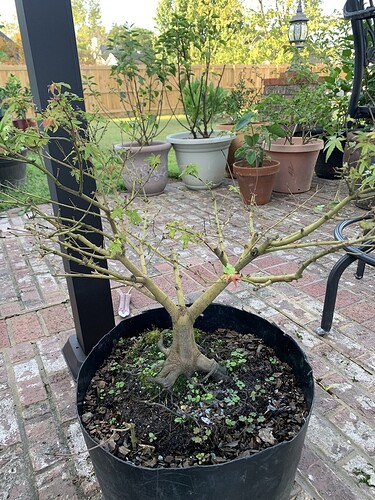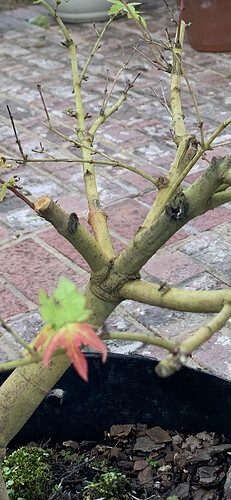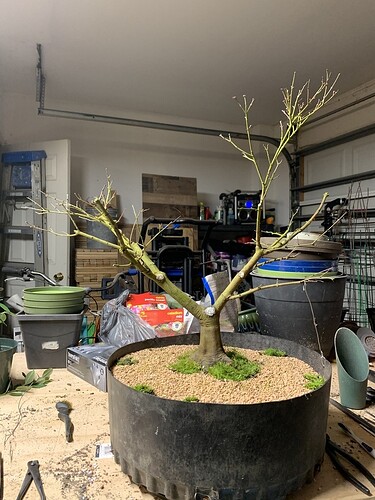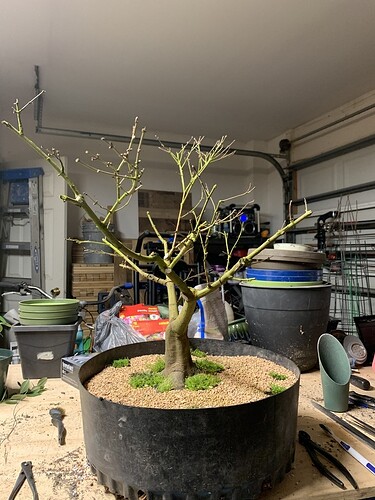I bought a Japanese Maple towards the end of the summer here in NC which has a beautiful trunk and root flare but very poor branch structure. I know it’s going to need a ton of training. I’m relatively new to Bonsai and am excited to start this trees journey but I’m unsure about how to proceed on this tree. It has 3 main branches that emerge from the top of the trunk, has several locations where 3 or branches emerge from one location and there is a ton of unoccupied space (due to broken branches at the nursery). I know I have to remove several branches to avoid swelling and reverse taper but I think it’ll have virtually no shape to it if I do. Any input would be much appreciated.
I would begin by using some zip ties to close the obtuse angle between the main trunks/ branches. Then I would only cut off what is actually causing a flaw such as inverse taper at this particular moment. Looking at this photo I see only 2… Maybe 3 branches that need reduction or removal. Then leave it be until next year.
I figured I’d have to close that gap a little. My main concern was these 2 knuckles. Thanks for the input.
I would remove the branches that offers the least long term potential. Think about the movement you want in the final design and I think you will know which should come off. You can reduce them slowly or cut back to the collar this fall or spring.
Sounds good. Thank you
Remember that maples will almost always back bud a great deal after a major cut back. This allows you to cut back dramatically to establish a good line and regrow branches. This can even be to the point of cutting back to a single line with good direction change and taper. As a result, I would not be afraid to cut back to a good line eliminating all of the structural flaws. Ideally this leaves the trunk line and a side branch, but the side branch can be skipped if needed.
Based upon the first photo I might do something like this. The edit is very crude, but I hope it conveys the idea.
I knew I was going to have to be pretty aggressive with this first pruning in order to get it to a point that’s workable. I’m new to bonsai so I guess I’m just looking for the confidence to do it. The cuts that you highlighted to remove are almost the exact places I was thinking. Thanks for the kick in the rear Marty.
First off, congratulations on a very nice piece of nursery stock! I absolutely love the nebari and the wild looking surface roots!
My immediate thought was to chop off either one of the two thick branches (judging from the picture I’d chop the one going to the right), I think the angle between the two is a bit too obtuse. That would leave a nice slanted trunk line with good taper, though with a big wound that would take long to heal and might never be smooth. But with the gnarly root base a hollow/ugly scar from the branch removal might not look totally out of place, if that’s a look you’d like.
I would still just close the obtuse angle with zip ties and remove just the 1 or 2 branches that are causing or will cause inverse taper. This way you do not create scarring that will never heal over and you leave as many branches as possible to drive forward its development. It seems to me it would make a great broom style tree, why try to make it something else and hinder its progress? You can have an exceptional tree in a few years or a decade. Either way the choice will be yours and there is no right or wrong in either approach.
I completely agree, trying to close the obtuse angle and save both trunks is a great option!
I just wanted to offer an alternative solution. It was in no way my intent to discredit any other options, only to present another possibility to consider.
No offense was taken @Micke. Thank you for your alternatives. Also, @Crnagel you may want to take air layers off the parent tree as a way to cultivate well ramified starter material.
Thought I would add a different look at what is there. I can a really nice trunk line (in blue) and the first big cuts in red. I would be a slow build and the wounds would take time to heal and would most likely leave a scar. It might still be worth it for the nice trunk you could have. Also that trunk line would need a repot at a different angle which mean rebuild the nebari on the right side. But there is a crossing root there that needs to removed at some point.
Perfect illustration of what I tried explaining in words!
But wouldn’t it be beneficial to leave the straight branch pointing back to help with sap flow and wound healing? Admittedly, it’s straight and not that nice, but it will probably bud back and could then be heavily cut back leaving a nice thick (defining?) branch. Or do would new growth spout from the cut site that could be used to help with the healing?
I do not see this as a sustainable structure.
Weiser`s design is sound for future growth. Those big wholes need to be cut off now. Back to the two branches, as he indicates. Grow the tree from there. You will be happier with it.
Kevin’s design does not deal with the whirl on the left trunk. Two of the four(?) Needs to go. Now. It will leave a large unhealable scar. You will need to grow limbs, and reorient the bees. That will lose the nice rootage that you already have.
Odd tree ,
Also, lose the overlapping root on the right big root. Now.
I appreciate everyone’s input. I’ve been thinking about it for quite some time and I agree the best course of action is as Marty Weiser describes. I think it’ll make for the best overall design with the least amount of scaring and that crossing root definitely needs to be addressed. Also, the air layering is a great idea that didn’t even occur to me.
I don’t know why, but the nebari reminds me of the Ents in the Lord of The Rings movies 
@KurtP, I agree about the whorl, I was only looking at the initial trunk line. It is always interesting in what each of ud see in raw material. We do both agree on the crossing root. In my everyday work I have seen that actually harm the long term health of a tree.
So after repotting this guy I found that it needs severe root work. It had 3 roots the thickness of a quarter (USA) that went straight down. Thankfully a majority of the feeder roots were not coming from them so they have been reduced. I didn’t address all the issues in the top part of the tree since the roots were so severely altered. It’s been 2 weeks since the repot and I have buds swelling and a few ready to open. Going to let it go crazy and address the rest of the root issues next spring if the tree looks up to it. Here’s photos from all 4 sides after the repot. As you can see there’s still a lot of work to be done. I’ll take photos of the buds swelling later when I get home.








